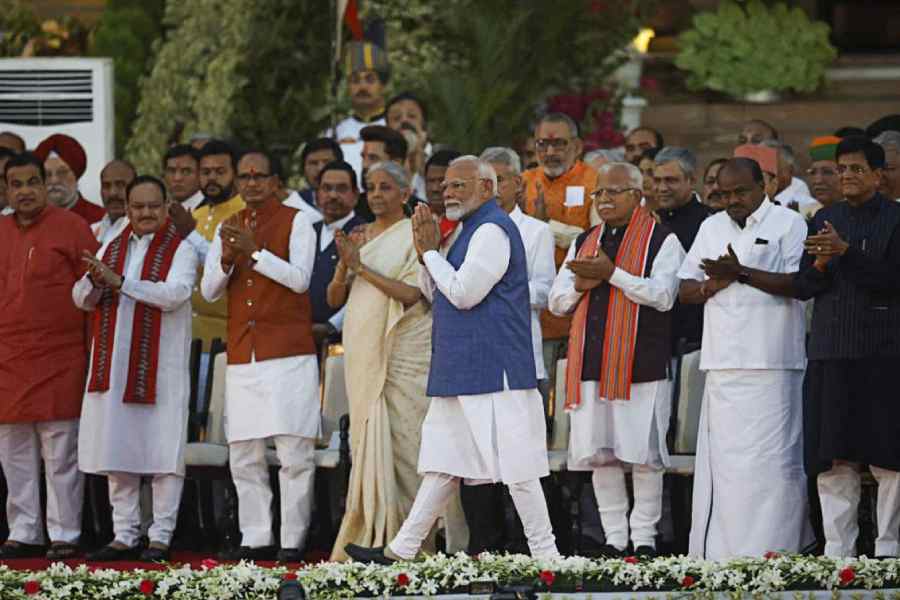COALITION CHALLENGE: Propped by allies, Narendra Modi has become the first since Jawaharlal Nehru to be sworn in India’s Prime Minister a third successive time.
He will, however, now be leading a coalition government dependent on allies, a situation India’s first Premier never had to face.
As Modi, donning a blue half-jacket over his white kurta-pyjama, was sworn in by President Droupadi Murmu on the forecourt of Rashtrapati Bhavan on Sunday, his gaze would have fallen on two stalwarts seated in the front row of the audience. Telugu Desam Party boss Chandrababu Naidu and JDU chief Nitish Kumar will have a big hand in deciding the stability of Modi’s new government, and both have a history of switching sides to fulfil their personal and regional interests.
Seventy-one ministers — 30 of cabinet rank, 5 junior ministers with independent charge, and 36 junior ministers — took the oath of office, the group’s composition as much a nod to continuity as to the compulsions of coalition. Twelve in all — five cabinet ministers, two MoS (independent charge) and five MoS — were from the allies.
Modi has retained his core team from the previous government, apparently intent on playing it as safe as he can at a time of unfamiliar uncertainties for him.
Senior BJP leaders from the earlier government took their oath in the same order as in 2019. After Modi, it was Rajnath Singh, followed by Amit Shah and Nitin Gadkari, who has acquired the reputation of being something of an irritant to the top leadership.
The surprise, whatever it was worth, came in the form of J.P. Nadda, whose extended term as party president ends in June, making a return to the government. Nadda, health minister in the first Modi government, was sworn in after Gadkari. His induction implies the BJP will now have a new president.
The BJP dominated the list of 30 cabinet ministers, with 25. The other five were Karnataka ally and JDS leader H.D. Kumaraswamy, young Desam leader Rama Naidu, JDU veteran Rajiv Ranjan aka Lalan Singh, Jitan Ram Manjhi of the Hindustani Awam Morcha, and the biggest winner of the day — Lok Janshakti Party leader Chirag Paswan.
Members of two other key allies — the Shiv Sena from Maharashtra and the western Uttar Pradesh-based Rashtriya Lok Dal — were accommodated as ministers of state with independent charge. These were Sena MP Prataprao Jadhav and RLD leader Jayant Chaudhary, grandson of former Prime Minister and Bharat Ratna awardee Charan Singh.
Praful Patel, senior leader from Ajit Pawar’s NCP, was said to be on the list of junior ministers with independent charge but did not turn up.
Patel was quoted as telling reporters that he had been a cabinet minister in the
erstwhile UPA government — when the undivided NCP of Sharad Pawar was a
Congress ally — and a junior minister’s job was unacceptable because it amounted
to a demotion.
The other key inductee was former Madhya Pradesh chief minister Shivraj Singh Chouhan.
Chouhan, an old-timer edged out of chief ministership despite a thumping BJP victory in last year’s Assembly polls, had contested the Lok Sabha polls from Vidisha and won by a margin much bigger than Modi’s in Varanasi. He is expected to get a key portfolio.
The other former BJP chief minister to be sworn in as cabinet minister was Manoharlal Khattar, replaced as Haryana chief minister just ahead of the general election and made to contest from the Karnal Lok Sabha seat.
One interesting new face in the cabinet would be that of Gujarat BJP chief C.R. Paatil, known to be close to Modi but not a favourite with Amit Shah, the Number Two in the government.
Omissions
At least 20 ministers from the previous government, including Smriti Irani and Rajeev Chandrasekhar, lost the elections. None of them were inducted into the new government.
One of the biggest absentees was Anurag Singh Thakur, re-elected from Hamirpur in Himachal Pradesh.
Sources close to him indicated he could be given an important responsibility in the party organisation. Others, however, suggested he may have been punished for the BJP’s defeat in Assembly segments within his Lok Sabha constituency in the state elections of 2022, when the BJP lost Himachal.
The other cabinet ministers from the previous Modi government to be left out were Parshottam Rupala from Gujarat, and the political heavyweight from Maharashtra, Narayan Rane.
Rupala’s controversial comments against the Kshatriya community had led to huge protests and were said to have harmed the party. Rupala, however, won from Rajkot.
Annapurna Devi from Jharkhand, a junior minister from the previous government finds herself promoted to cabinet rank.
Guests
The swearing-in, which Modi himself termed “historic”, had a guest list of 8,000 that included Mukesh Ambani and Gautam Adani, top industrialists whom Modi had accused during the campaign of sending “tempos full of black money” to the Congress.
Also in attendance were film stars Rajinikanth, Shah Rukh Khan, Akshay Kumar and Anil Kapoor. Leaders from Bangladesh, Sri Lanka, Bhutan, Nepal, the Maldives, Mauritius and Seychelles too were present.











